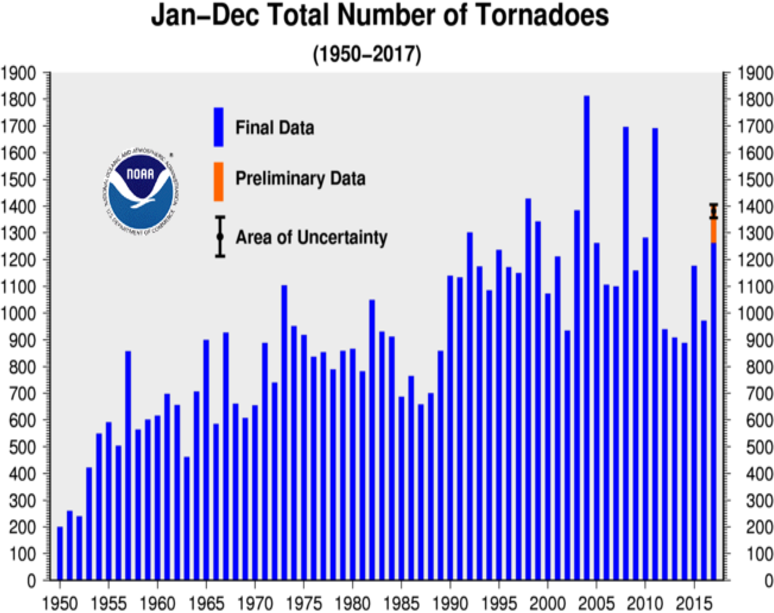https://www.spc.noaa.gov/wcm/2017/torngraph-big.png
The year 2017 was a relatively busy year for tornadoes in the US, ranking third since 2005 on preliminary data.
This was mainly due to a spurt in numbers in January to March, most of which were weak EF-0 and EF-1 tornadoes.
There were, though, three EF-3s in an outbreak in January, which sadly led to 20 fatalities.
https://www.spc.noaa.gov/wcm/2017/ptorngraph-big.png
As for longer-term trends, regular readers will recall that we need to discount weaker tornadoes, as NOAA explains:
One of the main difficulties with tornado records is that a tornado or evidence of a tornado must have been observed. Unlike rainfall or temperature, which may be measured by a fixed instrument, tornadoes are short-lived and very unpredictable. If a tornado occurs in a place with few or no people, it is not likely to be documented. Many significant tornadoes may not make it into the historical record since Tornado Alley was very sparsely populated during the 20th century.
Much early work on tornado climatology in the United States was done by John Park Finley in his book Tornadoes, published in 1887. While some of Finley’s safety guidelines have since been refuted as dangerous practices, the book remains a seminal work in tornado research. The University of Oklahoma created a PDF copy of the book and made it accessible at John Finley’s Tornadoes (link is external).
Today, nearly all of the United States is reasonably well populated, or at least covered by NOAA’s Doppler weather radars. Even if a tornado is not actually observed, modern damage assessments by National Weather Service personnel can discern if a tornado caused the damage, and if so, how strong the tornado may have been. This disparity between tornado records of the past and current records contributes a great deal of uncertainty regarding questions about the long-term behavior or patterns of tornado occurrence. Improved tornado observation practices have led to an increase in the number of reported weaker tornadoes, and in recent years EF-0 tornadoes have become more prevalent in the total number of reported tornadoes. In addition, even today many smaller tornadoes still may go undocumented in places with low populations or inconsistent communication facilities.
With increased National Doppler radar coverage, increasing population, and greater attention to tornado reporting, there has been an increase in the number of tornado reports over the past several decades. This can create a misleading appearance of an increasing trend in tornado frequency. To better understand the variability and trend in tornado frequency in the United States, the total number of EF-1 and stronger, as well as strong to violent tornadoes (EF-3 to EF-5 category on the Enhanced Fujita scale) can be analyzed. These tornadoes would have likely been reported even during the decades before Doppler radar use became widespread and practices resulted in increasing tornado reports. The bar charts below indicate there has been little trend in the frequency of the stronger tornadoes over the past 55 years.
https://www.ncdc.noaa.gov/climate-information/extreme-events/us-tornado-climatology/trends
Not that this stops NOAA continuing to publish grossly misleading graphs, such as the one below:
https://www.ncdc.noaa.gov/sotc/tornadoes/201713
Since NOAA also appear reluctant to update their graph for strong tornadoes beyond 2014, I will help them out:
https://www.spc.noaa.gov/wcm/#data
Despite those three EF-3s in January, the year ended with a record low 15 EF-3s and stronger, equalling the records set in 1987 and 2016.
There were also only two EF-4s, well below the mean of 7.4, and no EF-5s at all, the strongest tornadoes of all. Indeed, we have now gone five years without an EF-5.
It is evident that strong tornadoes have been in a steady decline since 1970.
As for this year, we are now through the season when we can expect to see most tornadoes and the strongest ones. So far the year is running at the lowest number since 2005.
Provisionally, there have only been four EF-3s and nothing stronger, which is extremely low.
We keep being told that weather is becoming more extreme, but as far as tornadoes go it is the opposite which is true.
Read more at Not A Lot Of People Know That


























Tornados like Hurricanes were suppost to be the results from Global Warming/Climate Change according to Al Bore and the Greens if you realy want to believe their load of Malarkey